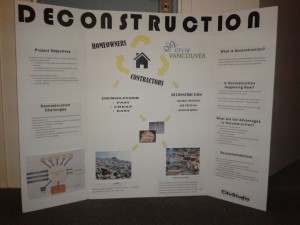April flowers are popping up as the winter semester is coming to end for another year, here at UBC. We are just about done with this CBEL project. All that is left is the CityStudio Expo tomorrow. If you’re free Saturday April 6, anytime from 10am-5pm, you should definitely come to the Museum of Vancouver and check out all sorts of student projects from around the city.
On Monday March 25, we had our first poster presentation. In the campus’ Civil Design Studio, a healthy crowd of people were moving around all the CBEL posters. It was great to see the great diversity of projects our classmates were working on during the semester. We had a chance to talk to quite a few different people at our own booth. It was a terrific opportunity to spread awareness about deconstruction as well as hold a conversation about how to shift the homeowner culture.
The poster and an accompanying report have been the two main deliverables of our project. To develop the content of these items, we contacted a number of contractors, totalling about 3 hours of interviews across the team. Collecting input from these professionals was incredibly interesting –it definitely challenged a lot of the team’s assumptions– and it seemed like the contractors genuinely excited to talk about their field to anyone who would listen. We hope CityStudio can find some use for our raw data.
The report focuses in on incentivising homeowners towards deconstruction. We were expecting contractors to be the ones resisting the idea, yet many contractors are actually in favour of deconstruction because, although there is extra cost, it invests in their own workers instead of a fee at the landfill. We quickly realised that it is the homeowners deciding to demolish. Those who pay the bills have the power.
Stepping outside the report, we found the entire project an interesting experiment. The first hurdle our team had to deal with was the ambiguous scope. It was frustrating at first to create our own task for the client, especially when it seemed the project was so very far along. The majority of our first couple team meetings were dedicated to trying to guess at what would be useful for CityStudio.
Another problem that we came to realise was that finding a meeting time in it of itself was not a simple task. Early on, we were pretty stubborn to get the entire team to every meeting, but being realistic with the nature of a student’s schedule, we had to accept that it simply wasn’t feasible.
Because we struggled early on, time to actually implement our plan was a bit rushed. Ideally, we could have had an extra week or so to get in a few more interviews. Despite this, the team is still satisfied with our work. The lesson learned here was that, regardless of how frustrating it may be, it is important to have good direction and it’s ultimately worth the time to figure it out.
Another big takeaway from the experience has been the sheer depth and complexity that exists in something as seemingly simple as waste management. There are so many actors and relationships and assumptions that are constantly swirling around that it can be quite daunting to try to step into. Again, the lesson here would be that any time that you can dedicate to trying to understand that actors already deeply invested into a system is worth it.
We wish CityStudio and the Deconstruction Hub project the best of luck in the future. It’s a little alarming how close the year 2020 seems. This is a super exciting project, and we believe it can have a great impact, not only on how waste is managed in Vancouver, but how new buildings are designed in the future.


Hi Team,
3 hours of interviews! This is amazing! Your results in terms of bottle-necks is also interesting – I am also surprised.
I appreciate your comments about the PROCESS of project management that you experienced this term. It seems clear that you have deepened your understanding of the complexities involved in large-scale, multi-year, urban infrastructure projects – something that you can take with you when you address your 4th year capstone design project.
I wonder if you have thought about the social hurdles of civil engineering practice. For example, how might a city engineer focus on demand-side management of utilities and services? Also, given the huge scope of your project, I wonder if you’ve thought about how best to prioritize project tasks.
Thank you for putting this significant effort into this project.
Sincerely,
Susan Nesbit